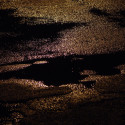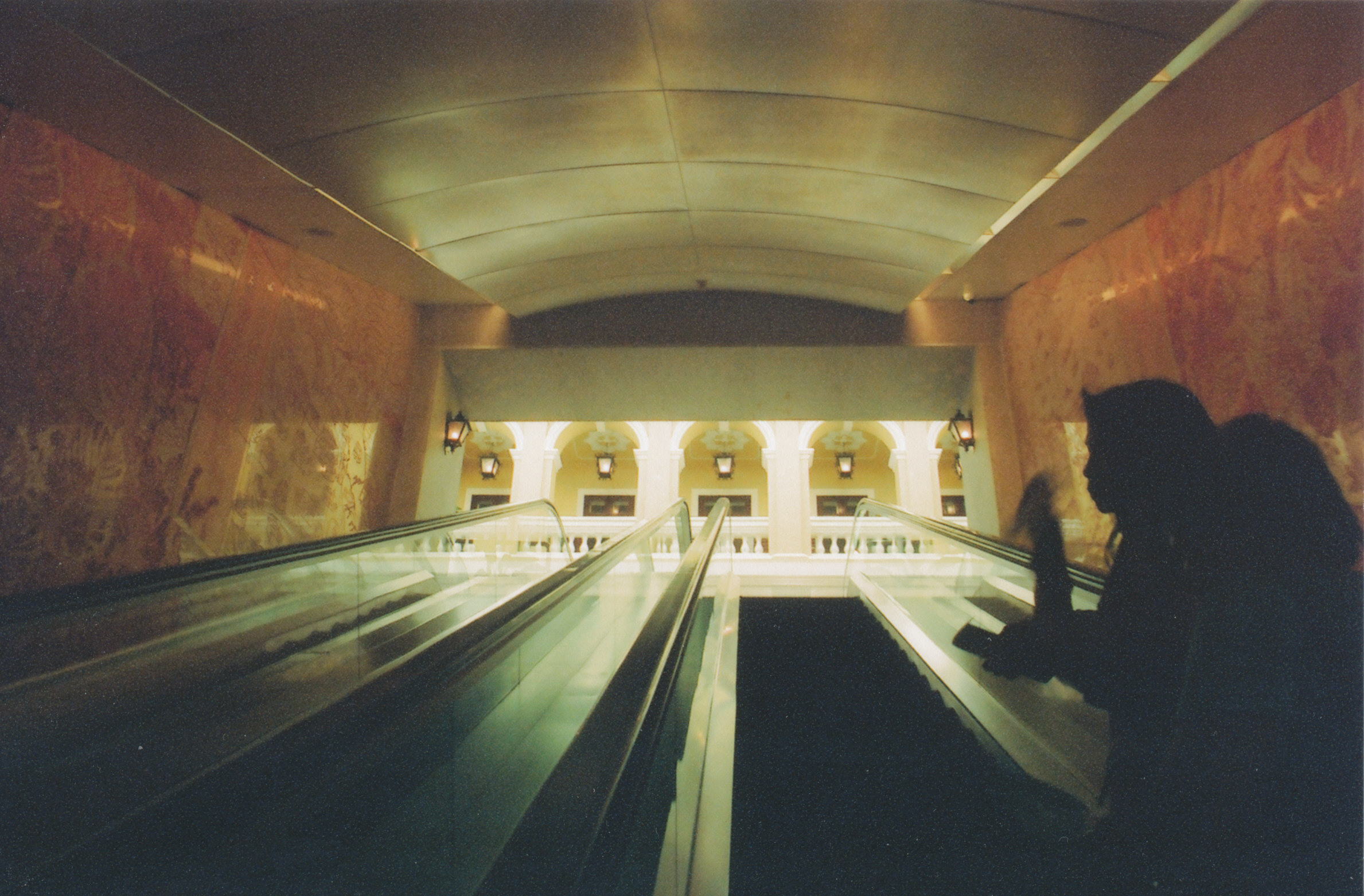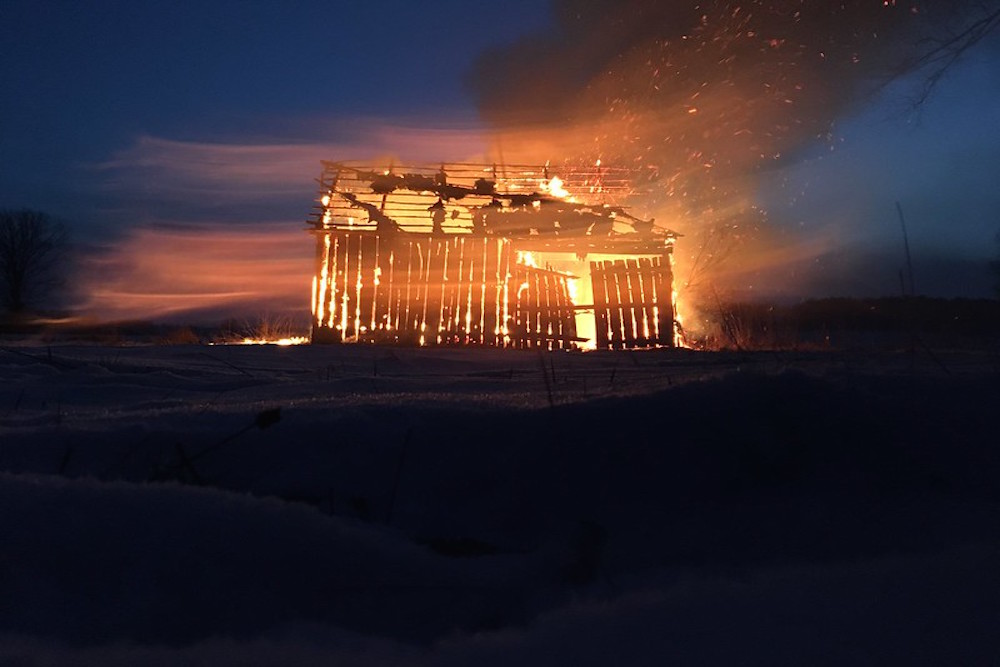Brenda crouches by the dog that’s been hit: its legs are together, the tire mark running from its backside to its nose, still twitching in a puddle. Brenda takes its pulse. It fades. She is two blocks from the shade of her apartment and she walks them whistling, she walks them to drop off the bags from the market and pick up another one big enough to fit this present inside.
She washes her face and with wet hands grabs her plastic swag-bag and the keys. She goes calmly down the stairs, putting on gloves and an apron, heading for the traffic lights, for the junction where the vendors set up their stands among the fallen leaves and the few believers or drunks who pass through here early on a Sunday. The dog is a young female, lying so close to the pavement that Brenda doesn’t wait for the red light before picking her up, and less blood leaks onto her surgical gloves than she would have expected. She then puts one hand under the dog’s head and with the other places the tail and the legs into the bag. She ties it up to avoid attracting curious looks on the way back, and, when she begins to tire of the weight, suspecting that the bag might leak, she picks up her pace until she reaches the second floor.
The wide, high-ceilinged bathroom seems to be waiting for her first stray dog, the bathroom that, unlike the living room and bedroom crammed with films, newspapers, and boxes, is empty. Wearing a surgical mask, Brenda turns on the extractor fan, opens the bag holding the body––soft––and then the doors to the bathroom and the bedroom. Finally, she lies down on the bed for a couple of minutes, watching the bag from a distance. The room is an almost exact replica of the one she had at her mom’s a couple of days ago, the same cushions and blanket, the same wardrobe.
From the shelf, on her tiptoes, she takes down two sealed boxes before finding the one she’s looking for. She’ll need the scalpel inside the box to be able to open it, like those cartoon characters that break out of their cell to steal the key from the guard. She slowly puts the move out of her mind, scrapes at the tape with her fingernails and finds the little fine-bladed knife. It flashes and she lifts it up like a chalice, concentrating on its two blades, on the opportunity to christen it herself.
She opens the blinds this time and sunlight is added to the fluorescent strips; the box of utensils collected over the years stops the door from slamming in the current of air. Distracted by the extractor fan, she goes to find the radio in the living room and turns the volume on the CD player up to max. No one’s going to ring the doorbell here––it’ll have to be fixed next week––nor knock on the door. Tingling in anticipation of the plan beginning, Brenda hums a song to herself as she wanders around the apartment again. Life’s a journey, not a destination, she’ll say, staring at the ceiling, whenever anyone tells her to get on with something. The same journey that enabled her to disappear for three days without telling even her mother.
After rinsing the residual coagulated blood and mud in the sink, she dries the dog’s wound, pushing its entrails inside. Underneath, the brown is red, soon pink and then clear running water. Brenda cuts off and stretches out a piece of bandage, fastening it in a thick belt over the edges of the fur. She sews a stitch on each side of the hole, while on the patch a little spot of blood threatens to grow into a circle and then that darkness that indicates a leak. Brenda prepares an identical patch to replace it and leaves it on the toilet seat.
The scalpel shines even more between the mirror and the light bulbs. Finding an angle where they don’t blind her, she leans over the body, moulded like the water in the sink, covering it entirely. Too cautious in her first incisions, Brenda cuts deeply into the area at the base of the tail. When she’s half way round, she punctures the skin by accident, staining it. A couple of drops, enough to make her pause for a moment after observing the flickering pulse and remembering how in the countryside they used to slit the lambs’ throats: the bleat no radio can silence.
*
The flesh of Eugenio Renato Ramírez Benavides has become rigid. His blood pools underneath, staining it. As he gets colder his cornflower blue skin reddens in certain areas, depending on the incline. It’s more acidic than when he was alive, so enzymes are liberated, like lemonade slaking a thirst that will return when the muscle fibres dry out. The greenish skin develops blisters, filling all the pockmarks and unnecessary pores. The quest for smoothness, faithful guardian of the space its collapse will leave. Eyes that don’t see, and sink into the cranium, open. Blowflies take advantage of Eugenio’s many crevices to lay hundreds of eggs. They arrive like immigrants––blowflies attracted by the smell of gas, immigrants by the wealth it creates.
Within six hours their larvae have hatched, and they spend weeks feeding themselves on foreign tissues, making Eugenio Renato Ramírez Benavides swell. He sticks out his tongue. The tissues are now foam, due to the pressure of the gases, and they spill out along with other liquids from the nose, the mouth, and the anus. In smaller quantities they also escape from the wounds he sustained during the crash, as well as from new ones created by that same pressure. When things fade, the color actually remains in them, but it’s not visible now. What was bronzed, or cornflower blue, is almost white: the sum of all colors.
*
One. A lake turns animals into salt statues. It sounds like the plot of a sinister tale, but this is what happens in Lake Natron. The place takes its name from a natural chemical compound made up chiefly of sodium carbonate, deriving from ash from the nearby Ol Doinyo Lengai volcano.
Two. I found the creatures unexpectedly, all kinds of birds and bats washed up along the shoreline of the lake.
Three. Nobody knows for sure how they die, but it seems that the extremely reflective nature of the water’s surface confuses the animals, and they fall into the lake like birds crashing into glass windowpanes.
Four. The lake waters can reach temperatures of sixty degrees Celsius and are extremely alkaline. The sodium carbonate and salt make the creatures calcify and they are preserved as the sun dries them.
Five. This area is a large breeding ground for flamingos, which take the opportunity to nest in salt islands that sometimes form on the lake, protected from the approach of predators. But this presents other risks.
Six. I took these creatures from the shoreline, and positioned them as if they were alive. Resurrected and captivating, the Lake Natron salt statues.
*
Leaning on the morning frame wearing a blouse and knickers, drinking a fruit smoothie, Brenda checks that the rubbish truck is leaving with the organic waste: still an animal. Or a clock she took apart when she was young and, even with all the pieces to hand, she couldn’t get to work. Whatever makes the little hands go round doesn’t come back; after all the knocks, all the travels, the clock remains open and still, a whole animal, still.
Below two men throw the bags into the truck. The bags fall into the metallic roar, adding to it as the hatch is lowered, sweeping them inside. Brenda hears the dog’s bones crunching like an out of tune radio as they are crushed, and she jumps back from the window. Inside the apartment at the bottom of the bathtub, a stone submerged in salty water weighs down the dog’s stolen skin.
When she gets home from work, Brenda pulls back the shower curtain in order to hang up the skin, both the fur and the leathery side clean and salted. Later, at the end of her own shower, she soaks it like she does with her knickers, in freezing water that tightens the flesh. Wearing two towels, she goes out into the room where she left her apron, her wet feet leaving tracks on the floor for her return.
The salt has absorbed all the water that would have made the dog’s skin rot. Now Brenda washes the same skin with fresh water, rehydrating and cleaning it with cotton wool and her customary dedication. Every day, for ten days, though it feels like a single night. She brings home acid from work, to neutralize the leather, as well as a pH metre, though if it were up to her she’d use those little colored paper strips she’d learned with as a girl.
The evening after she brings home the metre, Brenda finally tans and oils the leather and dries it in the sun another day, making sure the skin side is always facing down so it can be moulded still wet. Only then does she call her only sculptor friend, telling him the dimensions of the animal and that she doesn’t mind what material he makes it out of. Plaster or plastic, it doesn’t matter. It’s a trial run.
*
Not a single embalmer! Brenda refuses to believe that no one in the whole country can help her, a country home to the oldest mummy in the world. If only the dogs had been run over in the desert, she wishes. She got a doctor to authorize her some time off work, though the creep invited her out after agreeing to do it; she had set aside the money for the journey there and back, for somewhere to stay, to pay someone who knew how to make the crevices of her dead dogs overflow with balsam. But no, millions of people dedicating their lives to all manner of idiocy, and not one of them an embalmer. For years she’s known the names of the embalming fluids, but saying them out loud makes them seem like the words of a song in another language chanted by a stadium full of people, or by the Chinchorro mummies, without the faintest idea of what they’re saying. Five years of veterinary training and she’s still left imagining they look like hair conditioner, the only kind of balm she is familiar with. Other balms, like the natron rich Egyptians used, penetrate blood vessels via syringes, priceless injection pumps, nasogastric tubes, aspirators––Brenda almost uses a hoover on the lowest setting.
Two females and a male, motionless in the same position. A neutral position, the four legs standing straight on the floor, the tail and head lifted slightly as though they’re waiting for something, the two females dwarfed by the sofa, the male next to the television. The room lacks only their eyes; Brenda has waited two weeks for them. It took her a while to find them and they were cheap, wholesale, from the Far East, sufficiently varied in size and color for the little variation found in the dead dogs themselves. It took her a while to find them because she didn’t want to ask that son-of-a-bitch hunter where he got his, the manager of that club with two head of cattle mounted on wooden shields, where she had to go to compare specific cuts to the leather. He had come up behind her, placing his hand on her waist. Or to have to put up with his flirting, his happy hours, his gazes. A hundred pairs of eyes from the Far East, wrapped up in a box with Brenda’s name and address on it.
*
Bacteria feed on Eugenio Renato Ramírez Benavides’s intestines and stomach. Flies, lodged in the orifices and creases, like the bags under his eyes, also feed on tissues. They make his hair fall out and his skin come away, transparent now because of the blisters. The fly larvae increase the pressure of the gases under most of the rest of the skin to bursting point. It now smells much worse than Miguel’s cock did that night, because oxygen is penetrating Eugenio and allowing flies to inhabit him. Around him has formed a kind of island or marking of territory, a sign of how much belonged to him, even if it was in a borrowed body that remains behind as the larvae are abandoning it. Worms arrive, more visible because he himself is becoming invisible, except for his bones. His skin is parched––lemonade doesn’t slake a thirst, it provokes one––and Eugenio Renato Ramírez Benavides’s cartilage is devoured by mites that search out the last few hairs and ligaments. For a while now his nails have not been painted, nor attached to his hands.
__
Ellen Jones has a B.A. in English literature and Spanish, and an M.St. in English Language from the University of Oxford. She is currently a Ph.D. candidate and teaching associate at Queen Mary University of London, researching English-Spanish bilingualism in contemporary fiction. She translates from Spanish into English and edits the criticism section of Asymptote.




